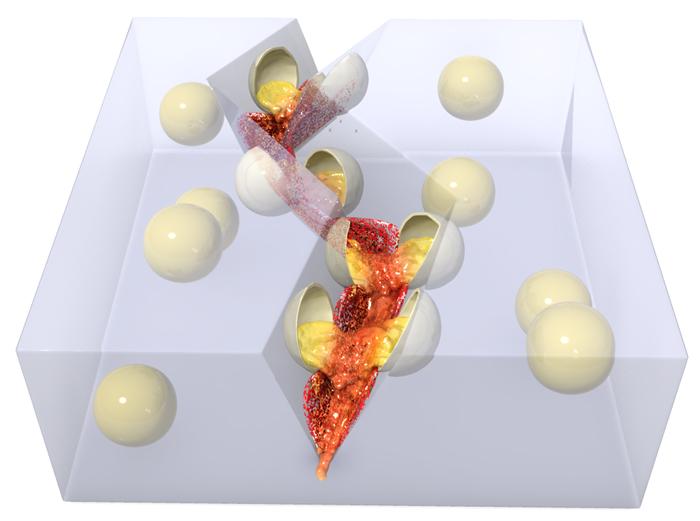Making the invisible visible: Color-changing indicators highlight microscopic damage

When cracks form, microbeads embedded in the material break open and cause a chemical reaction that highlights the damaged area. Image courtesy Nancy Sottos
The early warning system would be particularly useful in applications like petroleum pipelines, air and space transport, and automobiles – applications where one part's failure could have costly ramifications that are difficult to repair. Led by U. of I. materials science and engineering professor Nancy Sottos and aerospace engineering professor Scott White, the researchers published their work in the journal Advanced Materials.
“Polymers are susceptible to damage in the form of small cracks that are often difficult to detect. Even at small scales, crack damage can significantly compromise the integrity and functionality of polymer materials,” Sottos said. “We developed a very simple but elegant material to autonomously indicate mechanical damage.”
The researchers embedded tiny microcapsules of a pH-sensitive dye in an epoxy resin. If the polymer forms cracks or suffers a scratch, stress or fracture, the capsules break open. The dye reacts with the epoxy, causing a dramatic color change from light yellow to a bright red – no additional chemicals or activators required.
The deeper the scratch or crack, the more microcapsules are broken, and the more intense the color. This helps to assess the extent of the damage. Even so, tiny microscopic cracks of only 10 micrometers are enough to cause a color change, letting the user know that the material has lost some of its structural integrity.
“”Detecting damage before significant corrosion or other problems can occur provides increased safety and reliability for coated structures and composites,” White said. White and Sottos are affiliated with the Beckman Institute for Advanced Science and Technology at the U. of I.
The researchers demonstrated that the damage indication system worked well for a variety of polymer materials that can be applied to coat different substrates including metals, polymers and glasses. They also found that the system has long-term stability – no microcapsule leaking to produce false positives, and no color fading.
In addition to averting unforeseen and costly failure, another economic advantage of the microcapsule system is the low cost, Sottos said.
“A polymer needs only to be 5 percent microcapsules to exhibit excellent damage indication ability,” Sottos said. “It is cost effective to acquire this self-reporting ability.”
Now, the researchers are exploring further applications for the indicator system, such as applying it to fiber-reinforced composites, as well as integrating it with the group's previous work in self-healing systems.
“We envision this self-reporting ability can be seamlessly combined with other functions such as self-healing and corrosion protection to both report and repair damage,” Sottos said. “Work is in progress to combine the ability to detect new damage with self-healing functionality and a secondary indication that reveals that crack healing has occurred.”
###
The BP International Centre for Advanced Materials supported this work. Postdoctoral researcher Wenle Li was the first author of the work, and graduate students Christopher Matthews, Michael Odarczenko and Ke Yang were co-authors.
Editor's notes: To reach Nancy Sottos, call 217-333-1041; email: n-sottos@illinois.edu. To reach Scott White, call 217-333-1077; email swhite@illinois.edu.
The paper “Autonomous Indication of Mechanical Damage in Polymeric Coatings” is available online at http://onlinelibrary.
Media Contact
All latest news from the category: Materials Sciences
Materials management deals with the research, development, manufacturing and processing of raw and industrial materials. Key aspects here are biological and medical issues, which play an increasingly important role in this field.
innovations-report offers in-depth articles related to the development and application of materials and the structure and properties of new materials.
Newest articles

Bringing bio-inspired robots to life
Nebraska researcher Eric Markvicka gets NSF CAREER Award to pursue manufacture of novel materials for soft robotics and stretchable electronics. Engineers are increasingly eager to develop robots that mimic the…

Bella moths use poison to attract mates
Scientists are closer to finding out how. Pyrrolizidine alkaloids are as bitter and toxic as they are hard to pronounce. They’re produced by several different types of plants and are…

AI tool creates ‘synthetic’ images of cells
…for enhanced microscopy analysis. Observing individual cells through microscopes can reveal a range of important cell biological phenomena that frequently play a role in human diseases, but the process of…





















